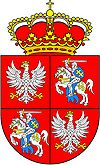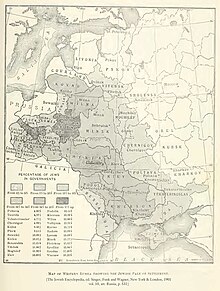This is an old revision of this page, as edited by Yakudza (talk | contribs) at 19:09, 27 December 2006 (Added text is founded on neutral sources. Does Not follow because of one POV sentence to delete whole text.). The present address (URL) is a permanent link to this revision, which may differ significantly from the current revision.
Revision as of 19:09, 27 December 2006 by Yakudza (talk | contribs) (Added text is founded on neutral sources. Does Not follow because of one POV sentence to delete whole text.)(diff) ← Previous revision | Latest revision (diff) | Newer revision → (diff)Jewish communities lived in the territory of Ukraine for centuries and developed many of modern Judaism's most distinctive theological and cultural traditions. While at times they flourished, at other times they faced periods of intense antisemitic discriminatory policies and persecutions.
Kievan Rus’

Jewish settlements in Ukraine can be traced back to the 8th century. Possibly, Jewish refugees from the Byzantine Empire, Persia, and Mesopotamia, fleeing from persecution by Christians throughout Europe, settled in the Khazar Khaganate. The first written document, Kievian Letter, that acknowleges existance of jewish community in Kievan Rus' is dated by early 10th century (or possibly 11th century).
The 11th century Byzantine Jews of Constantinople had family, cultural, and theological ties with the Jews of Kiev. For instance, some 11th-century Jews from Kievan Rus were participants in an anti-Karaite assembly held in either Thessalonica or Constantinople.
Halych-Volynia/14th Century
Main article: Halych-VolyniaIn Halychyna, the westernmost area of Ukraine, the Jews were mentioned for the first time in 1030. From the second part of the 14th century, they were under the patronage of the Polish kings and magnates. The Jewish population of Halychyna and Bukovyna, part of the Austro-Hungarian Empire, was extremely large; it made up 5% of the world Jewish population.
Polish-Lithuanian Commonwealth

From the founding of the Kingdom of Poland in the 10th century through the creation of the Polish-Lithuanian Commonwealth in 1569, Poland was one of the most tolerant countries in Europe. It became home to one of the world's largest and most vibrant Jewish communities.
Cossack era
Main article: Khmelnytskyi UprisingBohdan Khmelnytsky told the people that the Poles had sold them as slaves "into the hands of the accursed Jews." With this as their battle-cry, the Cossacks massacred a huge number of Jews during the years 1648–1649. The precise number of dead may never be known, but estimates range from a minimum 50,000 to several hundred thousands Jews killed: 300 Jewish communities were totally destroyed. The Polish-Lithuanian Commonwealth population losses in the Khmelnytskyi Uprising were over one million citizens killed. In reprisals, many thousands of Cossacks and peasantry supporting them were also murdered.
Russian and Austrian rule
Main article: Pale of SettlementThe traditional measures of keeping Imperial Russia free of Jews failed when the main territory of Polish-Lithuanian Commonwealth was annexed during the partitions of Poland. During the second (1793) and the third (1795) partitions, large populations of Jews were taken over by Russia, and Catherine II of Russia established the Pale of Settlement that included Congress Poland and Crimea.


See also
Russian Revolution of 1905

Counterrevolutionary groups, including the Black Hundreds, opposed the revolution with violent attacks on socialists and pogroms against Jews. The concessions came hand-in-hand with renewed, and brutal, action against the unrest. There was also a backlash from the conservative elements of society, notably in spasmodic anti-Jewish attacks — around five hundred were killed in a single day in Odessa. Nicholas II of Russia himself claimed that 90% of revolutionaries were Jews.
- Menahem Mendel Beilis
- Dmitry Bogrov
- Rose Pesotta
- Saša Schlümper (Samuil Nahimovich Beilin)
- Ida Silberblatt
- General Jewish Labor Union
Ukrainian People's Republic
Main article: Ukrainian People's RepublicDuring the rule of Symon Petlura, a series of mass pogroms were perpetrated against the Jews of Ukraine. Estimated 100,000 of civilian Jews were murdered. Some historians have claimed that Petliura did nothing to stop the pogroms, but some have claimed that he himself was not an anti-Semite and he tried to stop them by introducing capital punishment for the crime of pogromming, and that Petliura's only crime was being the head of state of country where the pogroms happened.
October Revolution

Persons of Jewish origin were over-represented in the Russian revolutionary leadership. However, most of them were hostile to traditional Jewish culture and Jewish political parties, and were eager to prove their loyalty to the Communist Party's atheism and proletarian internationalism, and committed to stamp out any sign of "Jewish cultural particularism". Many of them actively paricipated in the revolutionary terror of the Russian revolution and the Civil war that followed. In his article of February 8, 1920 "Zionism versus Bolshevism" Sir Winston Churchil describes the role of Jews in the revolutionary terror in the following way:
- "With the notable exception of Lenin, the majority of the leading figures are Jews. Moreover, the principal inspiration and driving power comes from the Jewish leaders. Thus Tchitcherin, a pure Russian, is eclipsed by his nominal subordinate Litvinoff, and the influence of Russians like Bukharin or Lunacharski cannot be compared with the power of Trotsky, or of Zinovieff, the Dictator of the Red Citadel (Petrograd), or of Krassin or Radek -- all Jews. In the Soviet institutions the predominance of Jews is even more astonishing. And the prominent, if not indeed the principal, part in the system of terrorism applied by the Extraordinary Commissions for Combating Counter-Revolution has been taken by Jews, and in some notable cases by Jewesses .
Jewish Bolsheviks from Ukraine played prominent roles in the Russian Revolution including, among others, Trotsky (Bronstein), Zinoviev (Apfelbaum), Kamenev, Radek, and Uritsky. Significant numbers of Jews did sign on to Bolshevik ideas of revolutionary terror that caused unprecedented loss of freedom, poverty, oppression and death. During the reign of Red Terror unleashed on the populations of Ukraine and Russia hundreds of thousands mostly innocent people died, some of them Jews as well.
The consolidation of Bolshevik rule brought the Jewish community both hardships and opportunities. Under War Communism (1918–21), when free commerce was banned and private businesses nationalized, Jews suffered great economic setbacks. Moreover, the Bolsheviks seemed determined to destroy the last vestiges of organized Jewish life. In April 1919 they abolished most community organizations. As part of their general antireligious propaganda they also closed down many synagogues and outlawed religious and Hebrew education. In Ukraine the Bolsheviks pursued a vigorous anti-Yiddish policy aimed at assimilating Jews; eg, the number of Yiddish books published declined from 274 in 1919 to 40 in 1923.
At the same time, formal and informal restrictions against Jewish participation in government and administration were abolished, especially for those who chose the path of assimilation. Special Jewish sections (the so-called yevsektsii) were formed within the Communist Party to facilitate Jewish participation, and it was often these groups that most strongly attacked the Zionist and traditional Jewish parties. Individual Jews benefited from the pro-Russian and pro-urban orientation of the Party, and many became part of the system, especially in education, the economy, and the middle echelons of the Party administration and government. Although only one-half of 1 percent of the total Jewish population joined the Bolshevik party, they constituted a large percentage of all Bolsheviks in Ukraine, in 1922 approx 13.6 percent of the Communist Party (Bolshevik) of Ukraine (CPU). Fully 15.5 percent of the delegates to the 5th and 7th All-Ukrainian Congress of Soviets in 1921 and 1922 were of Jewish origin.
Ukrainian Revolution
Main article: Ukrainian RevolutionIn Ukraine, the Central Rada established in March 1917 decided in late July to invite the minority nationalities (Russians, Poles, and Jews) to join its ranks. As a result, 50 Jews, from all the major parties, joined the Central Rada and 5 joined the Little Rada. The Jewish parties were also represented in the General Secretariat of the Central Rada (later the Council of National Ministers of the Ukrainian National Republic). Moisei Rafes, a Bundist, took on the post of general controller. Within the secretariat of nationalities, departments were set up for each minority and Moishe Zilberfarb, of the United Jewish Socialist Workers' party, was appointed under secretary for Jewish affairs. He became general secretary for Jewish affairs, with ministerial ranking, on the formation of the Ukrainian National Republic (20 November 1917), and then minister for Jewish affairs when the proclamation of Ukrainian independence was issued (25 January 1918). Responsibility for Jewish affairs under the Central Rada thus passed from a department (undersecretariat) to a secretariat and then to a ministry. An advisory council representing the main Jewish parties was formed on 10 October 1917 and the Provisional National Council of the Jews of Ukraine convened in November 1918. Yiddish was one of the languages used by the Central Rada on its official currency and in proclamations, and the law on national-personal autonomy gave non-Ukrainian nationalities the right to manage their national life independently. However, during the regime of Hetman Pavlo Skoropadsky, this law was rescinded (9 July 1918) and the Ministry of Jewish Affairs abolished.
Jewish participation in the Ukrainian famine
An accusation in the genocide against civilian population has been made against an ethnic Jew from Ukraine - Lazar Kaganovich. Togethter with Vyacheslav Molotov, Kaganovich took part in the All-Ukrainian Party Conference of 1930 and actively encouraged the policies of collectivization there, which, as many historians argue led to the catastrophic 1932-1933 Ukrainian famine (the Holodomor). As the result, millions of Ukrainians died during this artificial catastrophe. Similar policies also inflicted enormous suffering on the Soviet Central Asian republic of Kazakhstan, the Kuban region, Crimea, the lower Volga region, and other parts of the Soviet Union. Lazar Kaganovich is viewed by many if not as the mastermind but an active participant in this genocide.
In his book, The Harvest of Sorrow: Soviet Collectivisation and the Terror-Famine, Robert Conquest named Kaganovich together with Molotov, Pavel Postyshev and other Stalinist leaders of the USSR as having personal responsibilities for the famines. This does not mean that the Ukrainian Jewish community is accused as a whole of this crime, however, horrific atrocities of one of its prominent members cannot be overlooked either.
See also
Ukraine in World War II

Total civilian losses during the war and German occupation in Ukraine are estimated at seven million, including over a million Jews shot and killed by the Einsatzgruppen and Ukrainian collaborators. Jews were also targeted by Ukrainian nationalists in Nazi-backed pogroms, such as the ones in Lviv that killed over six thousand peoplec.
Post-war

Sources
- Zionism versus Bolshevism. A Struggle for the Soul of the Jewish People. Sir Winston S. Churchill."
- Encyclopedia of Ukraine. Ukrainian Jews
- Encyclopedia of Ukraine. Ukrainian Jews
- Robert Conquest, The Harvest of Sorrow: Soviet Collectivization and the Terror-Famine (1986)
See also
- Beilis trial
- Black Hundred
- Cantonist
- Galician Jews
- History of the Jews in Russia and the Soviet Union
- Jewish gauchos
- Reichskommissariat Ukraine
- Babi Yar
- Dnipropetrovsk
- Jewish Anti-Fascist Committee
- Lwów Ghetto
- Lwów Uprising
- Odessa massacre
| History of the Jews in Europe | |
|---|---|
| Sovereign states |
|
| States with limited recognition | |
| Dependencies and other entities | |